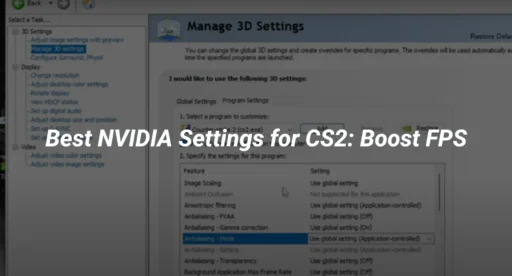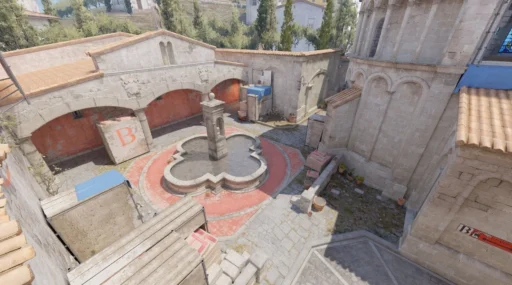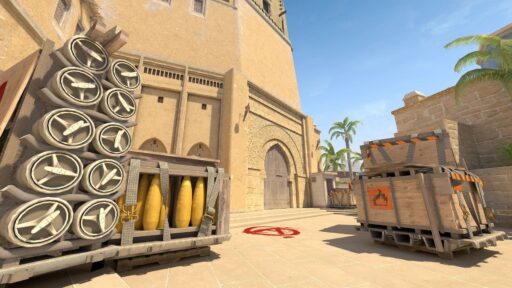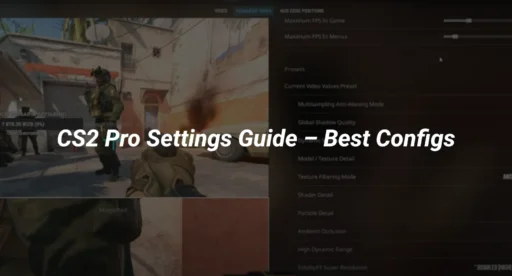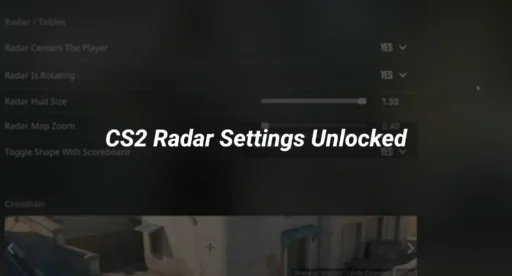Introduction: Why NVIDIA Optimization Matters in CS2
Counter-Strike 2 is one of the most competitive FPS games where every frame and millisecond counts. Unlike CS:GO, CS2 uses the Source 2 engine, which demands more from your GPU. Poor NVIDIA settings can lead to:
- Stuttering and inconsistent FPS
- Increased input lag, making your shots feel delayed
- Visual clutter that distracts from spotting enemies
This guide provides step-by-step optimizations for NVIDIA GPUs (RTX 20/30/40 series) based on:
Professional player configurations
Technical benchmarks (FPS vs. input lag)
GPU-specific tweaks (DLSS, Reflex, and more)
Let’s dive in.
1. Essential NVIDIA Control Panel Settings (Step-by-Step)
Step 1: Open NVIDIA Control Panel
- Right-click your desktop and select NVIDIA Control Panel.
- Go to Manage 3D Settings > Program Settings.
- Click Add and locate cs2.exe (default path: Steam\steamapps\common\Counter-Strike Global Offensive\game\bin\win64).
Step 2: Apply These Critical Settings
| Setting | Optimal Value | Why It Matters |
|---|---|---|
| Power Management Mode | Prefer Maximum Performance | Prevents GPU throttling for stable FPS |
| Low Latency Mode | Ultra | Reduces render queue for lower input lag |
| Vertical Sync | Off | Adds delay; never use in competitive games |
| Texture Filtering – Quality | High Performance | Boosts FPS with minimal visual loss |
| Threaded Optimization | On (if CPU-bound) | Helps with multi-core CPU utilization |
| Shader Cache Size | 10 GB (SSD users) | Reduces stuttering on map loads |
Pro Tip: Disable G-Sync if your FPS exceeds your monitor’s refresh rate (e.g., 240 FPS on a 144Hz monitor).
2. Best CS2 In-Game Video Settings for NVIDIA GPUs
Graphics Settings for Competitive Play
| Setting | Recommendation | Reason |
|---|---|---|
| Global Shadow Quality | Low | High shadows tank FPS on maps like Mirage |
| Model/Texture Detail | Medium | Balances visibility and performance |
| Shader Detail | Low | Reduces GPU load without affecting gameplay |
| Boost Player Contrast | Enabled | Makes enemies stand out |
| FidelityFX Super Resolution | Off (Blurry) | Use NVIDIA Image Scaling instead if needed |
Advanced NVIDIA-Specific Options
NVIDIA Reflex: Enabled + Boost (Reduces input lag by up to 30ms)
FPS Cap: Set to 2x your refresh rate (e.g., 288 FPS for 144Hz)
Motion Blur & VSync: Always OFF
3. GPU-Specific Optimizations (RTX 3060, 3080, 4090, etc.)
For Mid-Range GPUs (RTX 3060, 3070, 4060)
- Enable DLSS (Quality Mode) if FPS is below 144.
- Use NVIDIA Image Scaling (85% sharpness) if DLSS isn’t available.
- Lower Render Resolution to 1280×720 for max FPS (only if needed).
For High-End GPUs (RTX 3080, 4080, 4090)
- Disable DLSS (unnecessary for CS2’s low GPU demand).
- Set CS2.exe to “High Priority” in Task Manager.
- Disable Background Apps (Discord overlay, OBS previews).
For Laptop GPUs (RTX 3050 Ti, 4050)
- Enable “Optimus Disable” in BIOS (if possible).
- Use a cooling pad to prevent thermal throttling.
4. Driver & Windows Tweaks for Maximum Performance
Best NVIDIA Driver for CS2 (2024)
Recommended: Game Ready Driver 551.86 (most stable for CS2)
Avoid: Studio Drivers (higher latency)
Windows 10/11 Optimizations
- Disable Fullscreen Optimizations for cs2.exe:
- Right-click cs2.exe > Properties > Compatibility > Check “Disable Fullscreen Optimizations”.
- Set High Performance Power Plan:
- Search for “Power Plan” in Windows > Select “Ultimate Performance”.
- Disable Game Bar & DVR:
- Press Win + G > Settings > Disable all recording features.
5. Fixing Common CS2 Performance Issues
Problem: Stuttering or FPS Drops
Solution:
- Set -high -threads [CPU_CORE_COUNT] in CS2 launch options.
- Disable Hardware-Accelerated GPU Scheduling (Windows Settings > Display > Graphics).
- Clear Shader Cache in NVIDIA Control Panel.
Problem: High Input Lag
Solution:
- Enable Ultra Low Latency Mode + Reflex in NVIDIA Control Panel.
- Set Mouse Polling Rate to 1000Hz (in mouse software).
- Disable Windows Animations (System > Advanced > Performance Options).
For more fixes, see our CS2 stuttering guide.
6. Benchmark Results: Before vs. After Optimization
| GPU | Stock FPS (Avg) | Optimized FPS (Avg) | Input Lag Reduction |
|---|---|---|---|
| RTX 3060 | 180 | 260 | ~20ms |
| RTX 4070 | 320 | 450 | ~12ms |
| RTX 4090 | 480 | 600+ | ~5ms |
Final Thoughts & Next Steps
Optimizing NVIDIA settings for CS2 can boost FPS by 30-50% and reduce input lag significantly. Key takeaways:
- Ultra Low Latency + Reflex is a must for competitive play.
- DLSS helps mid-range GPUs, but high-end cards should avoid it.
- Windows optimizations are just as important as in-game settings.
Want to improve your gameplay further?
- Optimize your CS2 crosshair for better aim.
Learn how to rank up faster with pro settings.

